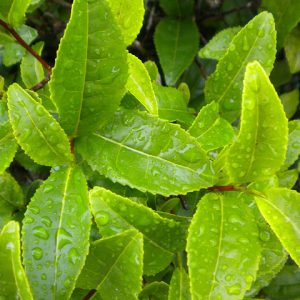Teaware: The Teapot

Yixing teapot in the traditional duoqiu design, modified with extra large lid bead and extra thick spout and handle. In very fine traditional zhuni Yixing clay. Artist: He Yen Ping, 2003
Materials
Porcelain
Porcelain is a classic and an optimum material for daily used pots. It retains heat well enough, and can be styled very flexibly to allow thinner spouts and thicker bodies. It can be formed and decorated in many ways.
Stoneware
Stoneware with glaze is good for its heat insulation property but because it is a more difficult material to mould cast delicate shapes, the designs seen in the market are usually quite rough. They handle less comfortably. The spout design generally suffers and the quality of the pour more difficult to be satisfactory. There are, of course, some exceptions. I have used carefully crafted ones that are very fine. More care is needed when selecting one of these. Some people categorize the specialist Yixing clay pots as stoneware. Technically they are, but I’d like to see them as a separate entity and will discuss them in a different article.
 Glass
Glass
Glass is good for showing the unfurling of the tealeaves and change of colours, but if you want quality infusion from fine teas, it is not a good choice. Use a thicker one if you have to use glass, and in occasions when you can use larger pots. The volume and the material helps to hold the heat for improved infusion effects.
Cast iron
Cast iron looks very nice with its rustic quality but the material radiates heat too readily and quality of infusion is not as desirable. Shorten the infusion time to half a minute or so if you have to use one. Choose one with a thicker material and those with enamel coating inside, which improves the insulation and prevents rusting. Keep a watchful eye in case bits of the coating start to fall off. Stop using it when this happens to avoid poisoning from the material.
Silver
Silver maybe by far the strangest thing to be used for teapots and yet so much aspired to. There was a trend of wrapping silver round Yixing pots for decoration. It is understandable this way. Using silver as the body material, however, is another thing. It maybe one of the most heat sensitive metals and it cannot be as thick (for the price) as cast iron pots to hold the heat so it gets too hot for handling instantly and the water gets cool down so quickly that infusion quality inevitably suffers. The reason it gets popular in the West and in North Africa maybe because people put so much sugar and/or milk in their tea that the quality of infusion really doesn’t matter, so long as the tea is “strong” enough. Some people in Morocco keep their extra sweet mint tea (white sugar + gunpowder tea + mint leaves) in huge silver pots on a heat source all the time. In such cases, as long as there is strong tea taste, it is usable. However, when you use a finer tea and need to realize its true taste, silver is not the choice. Having said that, I do not mind to be given a few pieces of nice silverware.
Aluminium
Aluminium (US: Aluminum) or tin pots are used in certain cafés or restaurants simply for economic reasons. By infusion effects, they are the worst of all the metals. I have seen people putting alu and tin pots on heat to make stronger tea, and I really cannot recommend this; not only for taste reasons but more importantly because that can cause poisonous materials released from the metal into the tea (or whatever you are cooking in them). Tin is especially bad. If a metal pot must be used for concerns of cost or convenience, use one that is made from anodized aluminium or thick stainless steel. Otherwise, use it as a transfer pot rather than making tea in it, such as they do in eateries and diners.
Plastics
Plastics, whether it is any of those polyesters (PET’s, PE’s, or PP’s etc) or high-tech polymers tested safe for even infant milk bottles, are materials that I am very skeptical about, not only for their safety, but also for the bad infusion results. Certain infusers, whether trendy designs or traditional ones, are made from thin or thick materials of this nature. Avoid them.













1 Response
[…] Teaware: The Teapot […]